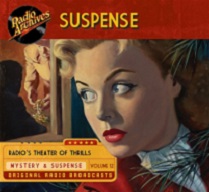Suspense is compounded of mystery and suspicion and dangerous adventure. In this series are tales calculated to intrigue you, to stir your nerves, to offer you a precarious situation and then withhold the solution… until the last possible moment when we again hope to keep you in…Suspense!
Suspense (1942-1962) aired “The Earth is Made of Glass” on September 27, 1945 as the 160th of its 945 episodes.
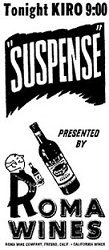 As recounted in the introduction to the more than 50 episodes of Suspense we’ve shared over the past fourteen years, it was such a rich goldmine of superior stories that when we found this one we couldn’t resist. Suspense was one of the most well produced, written, acted, and critically acclaimed of all radio shows during the Golden Age of Radio, many a film star jumping at the chance to perform in an episode, among them Cary Grant, Orson Welles, Jimmy Stewart, Susan Hayward, Vincent Price, Charles Laughton, Loretta Young, Peter Lorre, and Rita Hayworth. After many another radio show had gasped its last breath during the 1950s, Suspense (along with Yours Truly, Johnny Dollar) finally closed shop in September of 1962 whereupon radio historians proclaimed the Golden Age of Radio dead, television having become the medium of choice in America.
As recounted in the introduction to the more than 50 episodes of Suspense we’ve shared over the past fourteen years, it was such a rich goldmine of superior stories that when we found this one we couldn’t resist. Suspense was one of the most well produced, written, acted, and critically acclaimed of all radio shows during the Golden Age of Radio, many a film star jumping at the chance to perform in an episode, among them Cary Grant, Orson Welles, Jimmy Stewart, Susan Hayward, Vincent Price, Charles Laughton, Loretta Young, Peter Lorre, and Rita Hayworth. After many another radio show had gasped its last breath during the 1950s, Suspense (along with Yours Truly, Johnny Dollar) finally closed shop in September of 1962 whereupon radio historians proclaimed the Golden Age of Radio dead, television having become the medium of choice in America.
“There is no den in the wide world to hide a rogue. Commit a crime and the earth is made of glass. Commit a crime, and it seems as if a coat of snow fell on the ground, such as reveals in the woods the track of every partridge, and fox, and squirrel.” —from Ralph Waldo Emerson’s essay “Compensation”
The above selection from Emerson’s essay is the theme of this week’s chilling episode of Suspense. Starring acclaimed film actor Joseph Cotten (1905-1994, photo top right), the story opens after a hospitalized patient has died and his effects are collected for any next of kin, one of the few items belonging to the patient being a journal. Out of curiosity the doctor on call begins leafing through the journal and reading from it—and before we know it his voice has morphed into that of the deceased man, a neat trick on the part of the author of this episode as it brings the man’s story closer to home, to a more personal and relatable level for the listener. The man’s story is a curious one, as he attempts to question the nature of several kinds of murder and how the scales of morality are balanced out—how one soul (that of a murderer) is compensated (held accountable) for the death of another, when there is no connection between murderer and victim, especially if a murderer chooses a victim or victims at random, in a totally abstract and unconnected manner. Today we might call this karma, though Emerson uses the word “compensation” in the same way. Approached in the manner of an intellectual exercise, viewed as an ethical conundrum, the question becomes a serious philosophical exploration, one that the journal writer has decided needs proving one way or the other, and so sets out on a frightful experiment of his own devising. The logic of his test is measured in steps he dare not reject, and ere long the tension mounts, becoming almost palpable as the story drives mercilessly forward. The clever denouement is not only somewhat unexpected but fitting in a literary sense, the perfect capstone to this slickly constructed psychological Gedankenexperiment. This is well worth the time spent, the listener’s investment being amply rewarded in this superior example of what radio can accomplish with an intelligent script and fine acting.
[The question raised in this radio drama brings to mind the spate of frequent, and seemingly random mass shootings at malls or churches or other public venues, where there is no discernible personal connection between those murdered and the murderer, making the question explored here more timely than ever.]
(The CD linked at top includes “The Earth is Made of Glass” and 11 other superlative episodes of Suspense, featuring what some believe to be the greatest half hour of radio ever written and produced, “Sorry, Wrong Number” starring Agnes Moorehead, and for horror fans a dramatization of H.P. Lovecraft’s “The Dunwich Horror” is a welcome plus.)
Play Time: 29:48
{This episode of Suspense aired aired on a Thursday evening, which meant that the neighborhood gang would head for the nearby newsstand on their way home from school the following afternoon. Still in the mood for more adrenaline-fueled excursions into the dark corners of the human mind—which often led to mayhem and murder—they chose detective magazines guaranteed to set them on their way. Crack Detective Stories (1938-57), along with stories that kept readers coming back for 20 years, was also known for its many name changes, some 8 (depending on how technical one wanted to be). In 1945 it was a bi-monthly. Street & Smith’s Detective Story Magazine (1915-53) was the first pulp magazine devoted to detective fiction. It ran for an amazing 1,057 issues. For many of its earlier years (1915-35) it was a weekly or bi-weekly, though from 1936 through mid-1948 it had settled into a monthly schedule. Detective Tales (1935-53) ran for a solid 18 years, was very popular with readers, and usually included 12 stories in each issue. It was a monthly in 1945.}
[Left: Crack Detective, 9/45 – Center: S&S Detective Story, 9/45 – Right: Detective Tales, 9/45]
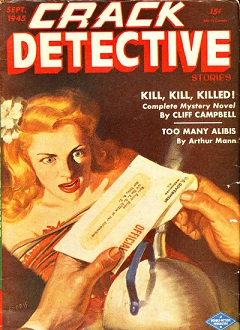
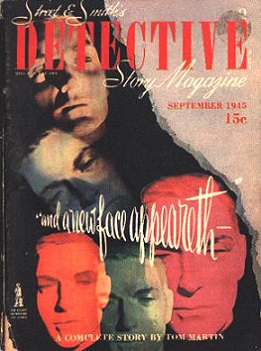
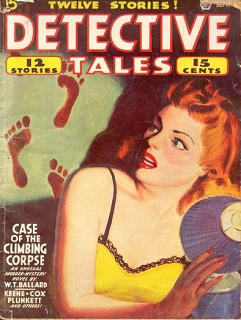
To view the entire list of weekly Old Time Radio episodes at Tangent Online, click here.
